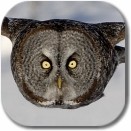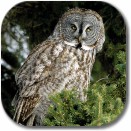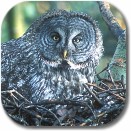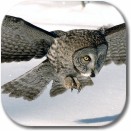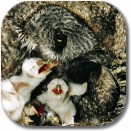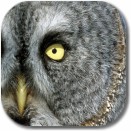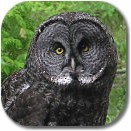 |
|
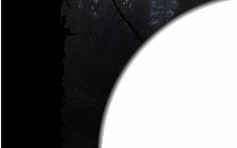 |
The Great Gray Owl is one of the icons of the world's boreal forests. In 1987 Manitobans adopted this magnificent bird as our Provincial Bird Emblem. One particular Great Gray Owl, Lady Gray'l, together with her friend, Dr. Bob Nero, played a major role in having this species selected. Follow this link to learn more about Lady Gray'l and the Lady Gray'l Fund for conservation and education. |
Manitoba's Provincial Bird Emblem, The Great Gray Owl An Impressive Bird (Click thumbnail images for larger views.) (If your browser won't play the background sound file, Click Here to hear the call of the Great Gray Owl.)
|
|||||
Finding An OwlGreat Gray Owls are permanent residents of the mixed-wood and coniferous forests of Manitoba in the extreme southeast and from Riding Mountain National Park north to the treeline. In some winters when Great Grays have difficulty finding food in thick forests, they often look for prey in meadows near settlements and, especially, along roadsides. Hungry owls seem almost fearless of people. The best places to look for them are along roads in or near provincal forests east of Winnipeg and south of Lake Winnipeg, especially on calm, overcast days. Residents of northern communities such as The Pas, Norway House and Thompson can expect to see these birds every winter and occasionally in summer. A Home For Owls |
|
||||
|
|||||
Lady Gray'l
Along with her handler and friend, Dr. Bob Nero, Lady Gray'l was a frequent visitor to schools, shopping malls, nursing homes and at various conservation programs. Together they educated thousands about conservation. She was the most travelled owl in Manitoba, the most photographed individual bird in North America, and her name is well known beyond our own provincial borders. It should be noted that Lady Gray'l and Dr. Nero played a major role in having the Great Gray Owl selected as Manitoba's official bird emblem in 1987. And in her memory, the Lady Gray'l Fund has been established at The Winnipeg Foundation. The Lady Gray'l Fund The Lady Gray'l Fund will be used to fund research, conservation and education projects directly relating to owls and other wildlife. Please consider making a donation. You can contribute online.
A donation to the Lady Gray'l Fund is tax-deductable and would make a great gift for any "birder" or nature lover in your life. (This picture icon
will take you on a slide show of Lady Gray'l's career. Watch some video of Lady Gray'l doing her thing for conservation at a Winnipeg mall and in a classroom:
|
A bird of mystery, the Great Gray Owl bears in its aloofness some of the remoteness of the vast northland; its plumage the color of lichens and weathered wood; its soft hooting, part of the wind.
Robert Nero For more owl-poetry by Robert Nero click here: |
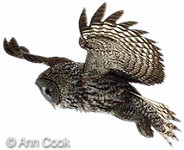
Credits
NatureNorth would like to thank Manitoba Conservation for allowing us to digitally reproduce the brochure: "The Great Gray Owl, Manitoba's Provincial Bird Emblem". (Originally funded by Manitoba Conservation, Cambrian Credit Union and the Manitoba Wildlife Federation.)
We would also like to thank the photographers who allowed us to feature their work on this page: Gordon Court, Robert R. Taylor and Ann Cook.
Header image for this page, "Moonlight Hunter", by Robert R. Taylor. Look for Robert Taylor's book, The Great Gray Owl - On Silent Wings (click thumbnail for book cover).
More owl links in NatureNorth: Manitoba Owl Calls | Noctural Owl Survey | Outdoors Column - A Hoo's Hoo
Return to NatureNorth's front page | Spring Issue | Summer Issue | Fall Issue | Winter Issue

